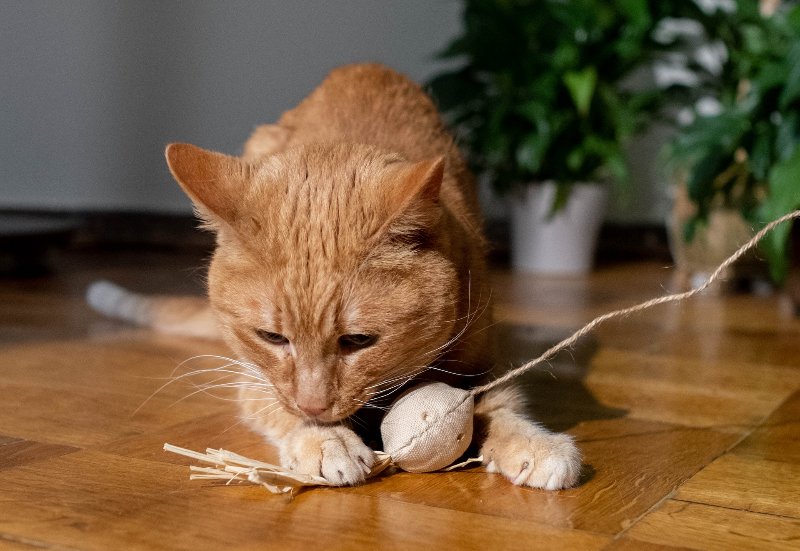VET APPROVED

The information is current and up-to-date in accordance with the latest veterinarian research.
Learn more »If you are considering adopting a semi-feral cat, you need to know that it can be time-consuming, overwhelming, and even a little scary. It’s important to realize that if the cat is semi-feral, it’s probably never had a stable home.
It is also highly possible that the cat has been abused, neglected, or abandoned before it came into your life, so it is going to be hard for the cat to trust you and settle in completely. Semi-feral means that the cat has been socialized but is still skittish and untrusting of places, things, and humans.
If you’ve adopted a semi-feral cat, we’ll give you five tips and tricks for helping the poor feline settle into your home and realize it can trust you and that it will be loved and treated well.

The 8 Ways to Help a Semi-Feral Cat Adjust to a Home
1. Respect the Cat’s Boundaries
The first thing you want to do is respect the cat’s boundaries. You can do this by paying attention to the cat’s mannerisms and actions when you’re close to it. If the cat is hissing, putting its back up, or even running from you, you must respect the cat’s space and let it be alone for a bit.
It’ll be much easier for the cat to relax if it knows you’re willing to let it get used to its new home at its own pace.
2. Create a Safe Space

To begin with, being in an unfamiliar home will be traumatizing for a cat that hasn’t had the best of lives. The cat is going to need a place to hide and feel secure. It’s a good idea to create a safe space for the cat so it can go off on its own to regroup
Put everything the cat will need in that space, such as its scratching post, litter box, food and water bowl, toys, and the cat’s bed so that it can be comfortable, fed, and happy, yet still alone. Never force the cat to come out and spend time with you and your family. Give the cat time, and it will come out on its own when it feels comfortable enough to do so.
As another option, if you're looking to give your cat something exciting, we know of an awesome scratcher that both encourages play and doubles as a stylish modern furniture piece. The Hepper Hi-Lo Cat Scratcher is designed with a curved shape for dynamic movement, is built to last with safe and sturdy birch plywood and thick cardboard, and offers three height options to ensure your cat enjoys the exercise, elevation, and excitement they crave ... and, it's affordable!
At PangoVet, we've admired Hepper for many years, and decided to take a controlling ownership interest so that we could benefit from the outstanding designs of this cool cat company!
3. Share Space with the Cat
Once you’ve created a safe space for your new feline friend, you can eventually start trying to share space with the cat. You don’t have to be touching or sitting beside your semi-feral cat to get to know it. Being in the same room with the cat can work wonders.
Settle down to work on the computer, watch TV, or read a book in the same room as the cat, but don’t talk or try to get too close to the feline. Just being in the same room will work to let the cat get used to you and get accustomed to your scent, appearance, and mannerisms. The more time you spend with your furry pal in the same room, the more the cat will realize you’re not a threat.
4. Play with the Cat

If you’ve ever been around a cat, especially a kitten, you know they love to play and usually can’t resist chasing a little ball or going after a dangling object. Whether it’s a laser pointer or a wand toy that wiggles, playing with your cat is sure to make it come out of its shell.
Don’t make sudden moves or try to pick the cat up. When the cat’s ready to be picked up, it’ll let you know. For now, playing with the toys with your cat will garner the best results. The rest will come with time.
If you need help, we recommend speaking with a veterinarian.
5. Introduce Touching Slowly
The one thing you don’t want to do with a semi-feral cat is rush touching it. If you try to pet it when it hasn’t accepted you as a friend, the cat will either flee and hide or attack you by clawing and scratching. In most cases, being able to pet, scratch, or cuddle a semi-feral cat isn’t going to happen overnight.
Introduce touching slowly but keep an eye on the cat’s visual and verbal clues. If the cat doesn’t want to be touched, it’ll let you know. Respect your new pet’s boundaries, go slowly, and only touch the cat when its body language tells you it’s okay to do so.
6. Talk to the Cat

While there’s debate as to whether a cat can understand what you’re saying, we know for sure that they learn a lot from your body language and the tone of your voice. Talk to your cat in a calm, soothing voice. Not only does this calm the cat, but it also helps it get to know you.
When you’re sitting in the room with the cat working, talk to it soothingly about anything to give it a chance to get used to your voice. You still need to speak softly and avoid petting the cat unless it comes to you.
7. Use Treats
Most felines are treat-oriented, which means treats can be an excellent tool for getting a cat to do what you want it to do. Positive reinforcement is always the best way to go when trying to train any animal, and a semi-feral cat is no exception.
Give your cat treats when it lets you stay in the same room, enables you to pet it, or even responds to your voice. The more you praise and reward your cat, the faster it will come around to your way of thinking and be less apt to bolt whenever it sees you or scratch you when you try to pet it.
8. Be Patient
The best thing you can do to help a semi-feral cat adjust to living in its new home is to have a ton of patience. Remember that these felines are often abused and abandoned and have no reason to trust the humans around them.
Give your new pet plenty of space and love, and always be patient with the little guy for the best results. You should never be mean to, yell at, or hit an animal to make it do what you want. If it’s mistreated, the cat may never grow to trust you.


Final Thoughts
When adopting a semi-feral cat, these tips will help the feline adjust to its new forever home. Remember, you have to be patient with any pet you bring into your home, but you’ll need to be extra patient with a semi-feral cat, as they haven’t had perfect lives, to begin with.
Always treat a cat like family; pretty soon, the cat will love and treat you like family. Cats deserve forever homes, just as people do. Make sure you let the cat adjust to your home on its terms for the best results.
Featured Image Credit: Lukáš Jančička, Pixabay













